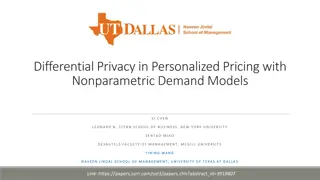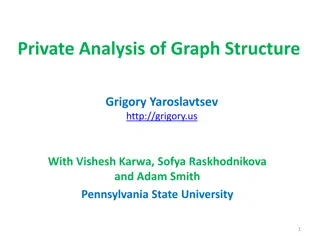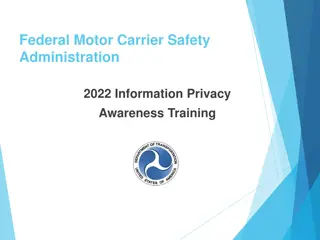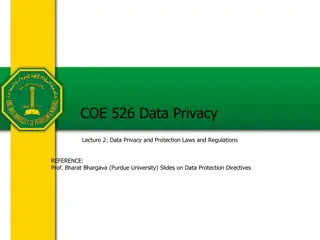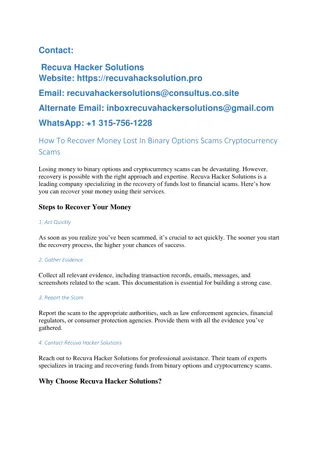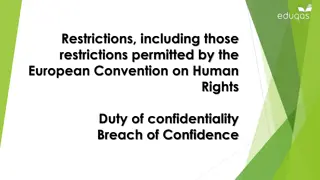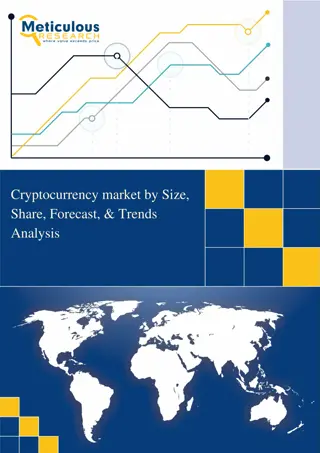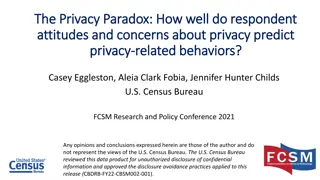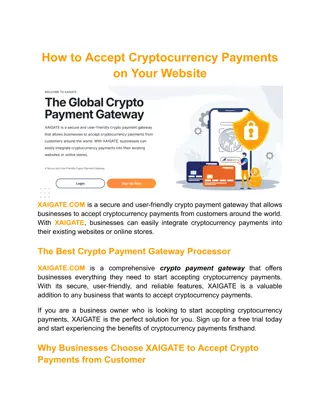Cryptocurrency Privacy Innovations Discussed in CS251 Fall 2020
Privacy measures in cryptocurrency transactions were explored in CS251 Fall 2020, focusing on techniques like zkSNARKs and commitment schemes to conceal account balances and transaction data from Rollup servers. The session delved into advancements in privacy-preserving technologies for blockchain applications.
Download Presentation

Please find below an Image/Link to download the presentation.
The content on the website is provided AS IS for your information and personal use only. It may not be sold, licensed, or shared on other websites without obtaining consent from the author.If you encounter any issues during the download, it is possible that the publisher has removed the file from their server.
You are allowed to download the files provided on this website for personal or commercial use, subject to the condition that they are used lawfully. All files are the property of their respective owners.
The content on the website is provided AS IS for your information and personal use only. It may not be sold, licensed, or shared on other websites without obtaining consent from the author.
E N D
Presentation Transcript
CS251 Fall 2020 (cs251.stanford.edu) Final topics: Cute Crypto Tricks Dan Boneh
Quick Recap: Rollup with privacy rollup server [A B: 2 ETH], ???? Layer 1 blockchain (e.g. Ethereum) atomic swap: [B Z: 1 ETH] [Z B: 2 BAT] ???? ???? root block 354 Merkle Tree Alice: 5 DAI 3 ETH Bob: 2 ETH Zoe: 1 ETH 3 BAT Tx
Quick Recap: Rollup with privacy rollup server [A B: 2 ETH], ???? Layer 1 blockchain (e.g. Ethereum) atomic swap: [B Z: 1 ETH] [Z B: 2 BAT] ???? ???? new root block 354 block 357 Merkle Tree Alice: 5 DAI 1 ETH Bob: 3 ETH 2 BAT Zoe: 2 ETH 1 BAT Tx
Privacy? The Rollup server sees: all account balances, and all transactions. Can we hide this from the Rollup server? Yes! Using zkSNARKs
Replace balances with commitments (simplified) rollup server A B: 2 ETH Layer 1 blockchain (e.g. Ethereum) [ -com, SNARK], ???? root block 354 Merkle Tree open of comA Alice: comA Bob: comB Zoe: comZ Tx (commitment to balances)
Replace balances with commitments (simplified) rollup server A B: 2 ETH Layer 1 blockchain (e.g. Ethereum) [ -com, SNARK], ???? new root block 354 block 357 Merkle Tree open of comA Alice: com A Bob: com B Zoe: comZ Tx (commitment to balances)
Replace balances with commitments (simplified) rollup server A B: 2 ETH Layer 1 blockchain (e.g. Ethereum) [ -com, SNARK], ???? new root block 354 block 357 Merkle Tree open of comA Alice: com A Bob: com B Zoe: comZ Tx (commitment to balances)
(zk)2-Rollup Problem: Rollup server sees identity of payer and payee Better data structure enables fully private Tx can even run DAPPs privately (e.g., ZEXE)
Discussion Topics Open problems in blockchains The future of blockchains and crypto currencies Where is this headed? A career in blockchains? Where can I learn more? EE374: Scaling blockchains (Winter 2021) CS255 and CS355: Cryptography Stanford blockchain conference (SBC)
BLS signatures one Bitcoin block inputs sig outputs Signatures make up most of Tx data. sig sig Tx1: Tx2: sig sig sig sig Can we compress signatures? Yes: aggregation! not possible for ECDSA Tx3: sig sig sig sig sig Tx4:
BLS Signatures Used in modern blockchains: Ehtereum 2.0, Dfinity, Chia, etc. The setup: G = {1, g, , gq-1} a cyclic group of prime order q H: M G G a hash function (e.g., based on SHA256)
BLS Signatures KeyGen(): choose random ? in {1, ,?} output sk = ? , pk = ?? G Sign(sk, ?): output sig = ?(?,pk)? G Verify(pk, ?, sig): output accept if logg(pk) = logH(m,pk)(sig) Note: signature on ? is unique! (no malleability)
How does verify work? A pairing: an efficiently computable function e:G G G such that e(??,??) = ?(?,?)?? for all ?,? {1, ?} and is not degenerate: ?(?,?) 1 verify test Observe: logg(pk) = logH(m,pk)(sig) if and only if e(g, sig) = e(pk, H(m,pk)) = = e(g, H(m,pk)?) = e(g?, H(m,pk))
Properties: signature aggregation [BGLS03] Anyone can compress n signatures into one Verify( pk , m , *) = accept pk1 , m1 1 aggregate * convinces verifier that for i=1, ,n: user i signed msg mi pkn , mn n single short signature
Aggregation: how user 1: pk1 = g 1 , m1 1=H(m1,pk1) 1 1 n user n: pkn = g n , mn n=H(mn,pkn) n Verifying an aggregate signature: (incomplete) i) e( , g) ? ?=1 e(H(mi,pki), g i, g) = e( i=1H(mi,pki) i, g) i=1 e(H(mi,pki)
Compressing the blockchain with BLS one Bitcoin block if needed: compress all signatures in a block into a single aggregate signatures inputs sig outputs sig* sig sig Tx1: Tx2: sig sig sig sig shrink block Tx3: sig sig or: aggregate in smaller batches sig sig sig Tx4:
UTXO set size 70M UTXOs Miners need to keep all UTXOs in memory to validate Txs Can we do better?
Recall: polynomial commitments ( ?)? commit(pp, f, r) comf commitment to f ?? eval: goal: for a given comf and x, y ??, construct a SNARK to prove that f(x) = y.
Homomorphic polynomial commitment A polynomial commitment is homomorphic if there are efficient algorithms such that: commit(pp, f1, r1) comf1commit(pp, f2, r2) comf2 Then: (i) for all ?,? ?? : comf1 , comf2 coma*f1+b*f2 comf1 comX*f1 (ii)
Committing to a set (of UTXOs) (accumulator) Let ? = {?1, ,??} ?? be a set of UTXOs ( ?)? Define: ? ? = (? ?1) (? ??) ?? Set: comf = commit(??,?,?) short commitment to ? For ? ?? : ? ? if and only if ?(?) = 0 To add U to S: comf comX*f U*f short commitment to ? {?}
How does this help? Miners maintain two commitments: (i) commitment to set T of all UTXOs (ii) commitment to set S of spent TXOs 1KB comT, comS Tx format: every input ? includes a proof (? ? && U ?) Two eval proofs: ?(?) = 0 && ?(?) 0(short) Tx processing: miners check eval proofs, and if valid, add inputs to set S and outputs to set T. That s it!
Does this work ?? Problem: how does a user prove that her UTXO ? satisfies ?(?) = 0 && ?(?) 0 ??? This requires knowledge of the entire blockchain user needs large memory and compute time can be outsourced to an untrusted 3rd party UTXO ? , fee polynomials S and T proof ? spend ? The proof factory
Is this practical? Not quite Problem: the factory s work per proof is linear in the number of UTXOs ever created Many variations on this design: can reduce factory s work to log2(# current UTXOs) per proof Factory s memory is linear in (# current UTXOs) End result: outsource memory requirements to a small number of 3rd party service providers
Taproot: semi-private scripts in Bitcoin
Script privacy Currently: Bitcoin scripts must be fully revealed in spending Tx Can we keep the script secret? Answer: Yes, easily! when all goes well
How? ECDSA and Schnorr public keys: KeyGen(): sk = ? , pk = ?? G for ? in {1, ,?} Suppose skA = ? , skB = ?. Alice and Bob can sign with respect to pk = ??? ???= ??+? an interactive protocol between Alice and Bob (note: much simpler with BLS) Alice & Bob can imply consent to Tx by signing with pk = ??+?
How? S: Bitcoin script that must be satisfied to spend a UTXO ? S involves only Alice and Bob. Let ????= ??? ??? Goal: keep S secret when possible. How: modify S so that a signature with respect to pk = ???? ??(???? , ?) is sufficient to spend UTXO, without revealing S !!
The main point If parties agree to spend UTXO, sign with respect to ???? and spend while keeping S secret If disagreement, Alice can reveal S and spend UTXO by proving that she can satisfy S. Taproot pk compactly supports both ways to spend the UTXO
END OF LECTURE Next lecture: super cool final guest lecture



